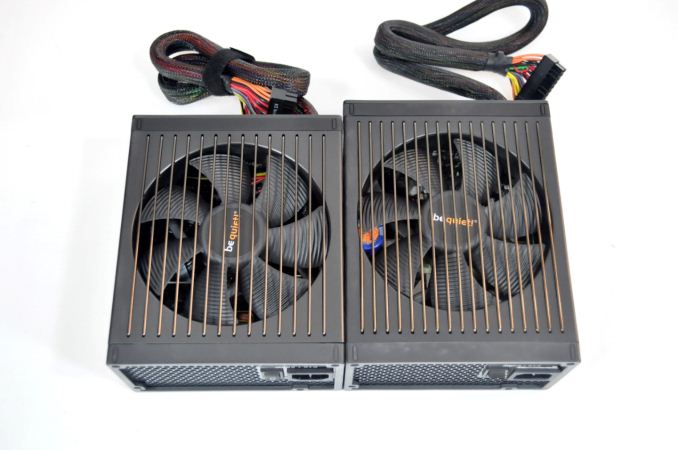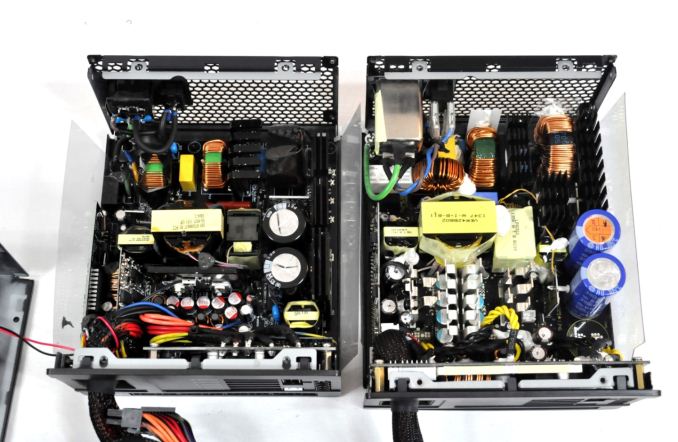Be Quiet! Dark Power Pro 10 650W & 850W PSU Review
by E. Fylladitakis on February 2, 2015 11:40 AM ESTConclusion
The conclusion of a review testing two products of the same series should have been uncomplicated and straightforward. Normally, such units would share the same number of features and similar characteristics; however, the Dark Power Pro 10 series is a clear exception to that hypothesis. Besides their visual similarities, the 650W and 850W versions are nothing alike.
Both units are externally similar, sharing the same visual modifications that create a neat, high quality appearance. They are among the best-designed PSUs that we have seen to this date. On the inside however, the two units that we have tested today are entirely different. The 650W version is based on a platform from Fortron-Source (FSP), while the 850W version is a modified Seasonic XP platform. Both versions perform well enough to meet the manufacturer's specifications but the 850W unit greatly outclasses the FSP-based version on all fronts. Ironically, the Seasonic XP platform is a design that is over three years old and still has little competition when it comes to overall performance.
be quiet! is a company focused on creating low noise products and markets their flagship Dark Power Pro 10 series as the "world’s quietest PSUs in the high performance category". The "world's quietest" part is pushing it a little, but both units displayed a good balance between thermal performance and acoustics. However, the more efficient 850W version outperforms the 650W unit, being capable of running at lower temperatures and generating significantly lower noise levels, even at higher loads. Nevertheless, both of the Dark Power Pro 10 PSUs delivered well and their difference on acoustics was expected from just their power output and efficiency specifications.
When it comes to electrical performance and specifically to the output power quality, the 850W version severely outclasses the less powerful unit. The Dark Power Pro 10 650W PSU delivered good electrical performance and power quality, well within the design guide limits, yet it's not what we would consider acceptable for a flagship product with such a price tag. On the other hand, the 850W version performed much better, delivering three times better power quality, much stronger voltage regulation, and higher conversion efficiency.
As far as build quality goes, most enthusiasts would (rightfully) argue that the Seasonic-based unit should be better. After all, Seasonic does have a better reputation than FSP when it comes to quality. However, this is not the case here, as both units are on equal footing as far as the build quality goes. The soldering and assembly of either unit is excellent, without any flaws that we could find.
Moving over to the internal components, the only noteworthy difference is the presence of the CapXon polymer capacitors in the 650W version, while the 850W unit is using Japanese capacitors all around. CapXon is a fairly reputable company and their polymer capacitors are among the best worldwide, but be quiet! should be bragging about using "premier quality Japanese capacitors" only in the features list of their 850W Dark Power Pro 10 PSU.
We found the Dark Power Pro 10 650W unit retailing for $180 at the time of this review, while the 850W version can be found selling for $240. Both price tags are very steep, especially when you consider that the Seasonic XP2 860W PSU can be bought for $165. Nevertheless, the 850W unit still has some potential, especially for people that care about the appearance and the cooling fan of their units. On the other hand, the 650W version is severely overpriced and its marketing potential seems very limited, particularly for the North American market. For example, the Corsair AX760, a 760W 80 Plus Platinum PSU, currently retails for $5 less than the Dark Power Pro 10 650W. The EVGA SuperNOVA 650G1, a PSU also based on a FSP platform (albeit a different one) can be found for just $80.
Due to its unique appearance and good cooling fan, the Dark Power Pro 10 850W does have some market potential – especially in Europe where the prices of be quiet! units are lower. However, short of a massive price cut (e.g. about half the current price), there is no reasonable scenario where the Dark Power Pro 10 650W can become a financially interesting choice. It's not that the Dark Power Pro 10 650W is bad; however, it is greatly outclassed by the Dark Power Pro 10 850W and terribly overpriced to stand any hope in the North American market.












25 Comments
View All Comments
maeda_toshiie - Monday, February 2, 2015 - link
"CapXon is a reputable company and their polymer capacitors are among the best worldwide"????? You do know CapXon's reputation and its position in the cap quality rankings...?!
Tator Tot - Monday, February 2, 2015 - link
There's a large difference between Polymer Capacitors & Electrolytic capacitors; CapXon's reputation comes from the quality of their electrolytic capacitors, not their polymers. Polymer capacitors, in general, are pretty hard to mess up though. You'd really have to try to make bad poly's.E.Fyll - Monday, February 2, 2015 - link
Perfectly so. CapXon is one of the ten largest and most reputable companies worldwide. They do have a mediocre reputation, half due to a couple of bad series and half because their products were used in horrible designs, but claiming that they are bad when therea re three dozen worse companies, or trying to suggest that only Japanese companies make good capacitors (in Taiwan), is...not useful.dishayu - Tuesday, February 3, 2015 - link
I can't objectively comment on the quality CapXon capacitors, but i've personally had a poor experience with them in the past and if you google for CapXon you see nothing but criticism and poor reviews. They are very commonly called crapxon on the internet. I don't see how any of that equates to being reputable.4745454b - Tuesday, February 3, 2015 - link
I sort of learned this lesson with my Antec Smart Power 450W. (If you know caps, you know what was in that.) Once I figured out there was a possible problem with my PSU I did what I could to prevent it. I blew the dust out every three months, and kept the tower as a whole as cool as possible. Then I after a year or so I bought a better PSU, the EA500. I don't remember the system it powered back then, probably my E6600 and 7750. My roommate needed a PSU after I upgraded it and I stuck that in there telling her to be gentle with it. Her system was an old P4 with a 9800 I think. (ATI 9800, not Nvidia 9800.) She didn't listen and stuck her case in that sweat box some/most desks come with because "that's where the computer goes right?" Needless to say the PSU didn't last long.The point I'm trying to make is even bad caps can do their job if you are nice to them. And just because a cap doesn't come from X region doesn't mean it's bad.
shadowjk - Friday, February 6, 2015 - link
I'm not familiar with the reputation of individual manufacturers, but even assuming that every capacitor make and model meet their manufacturer's specifications, you can still end up with capacitor death.Capacitors have a defined expected lifetime, at a specific temperature, voltage, and ripple current. The "headline" ratings usually put you in the ballpark of a few thousand hours life expectancy, which is only slightly better than how long a classic light bulb lasts before burning out.
In a poor design, the voltage and temperature limits are usually met by the design, but ripple current spec is exceeded (if we presume the designer aimed for half decent usable life). Temp and V can be checked by average Joe user, ripple current is trickier.
I wonder if the "reputable" jp manufacturers have strings attached to sales, to make sure nobody blows up their capacitors...
extide - Monday, February 2, 2015 - link
Wow, that scope is pretty ancient and crappy! I mean, at least go for the Rigol DS1054Z -- twice the sample rate (max) and tons of features for a really great price.E.Fyll - Monday, February 2, 2015 - link
The scope is old but it is reliable and excels the required specifications....and I want a much better oscilloscope too, but things do tend to be more complicated when you actually have to pay for it.
jordanclock - Monday, February 2, 2015 - link
As someone that isn't particularly well versed in oscilloscopes, would a "better" model make a difference in the results of an Anandtech review? I know you all strive for the highest quality in your reviews, but is this an example of little return on investment?E.Fyll - Monday, February 2, 2015 - link
Not more accurate results on the current tests, but a better oscilloscope would allow for more tests. It will happen eventually but, with a price tag of nearly $9000, it will take a while.